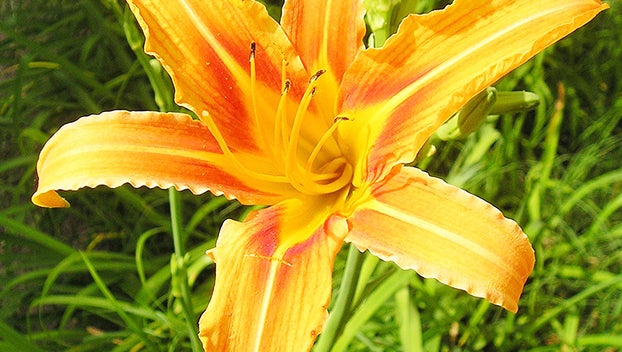TEXAS CERTIFIED EXPERT GARDENER — Daylilies provide sustainable benefits
Published 12:02 am Wednesday, April 17, 2024

- Daylilies (Hemerocallis fulva) are perennials that thrive in most USDA zones, including ours. The plants are hardy and can manage SETX blistering summers and require only slight maintenance once established. (onlyfoods.net)
|
Getting your Trinity Audio player ready...
|
As most of you know, I’m a Texas transplant and moved to SETX as an adult!
Growing up in little North Alabama town (Boaz), I don’t have too many plant-related memories, but the remaining are vivid, such as witnessing roadside daylilies burst into bloom.
For several weeks George-Johnson Road hosted thousands of vibrant, orange blooms that provided a riot of color … spectacular! Many of you may remember your grandmother’s yard having a large clump of bright orange or yellow daylilies.
The daylily plant family group, known as Hemerocallis, has significantly increased since the time of grandma’s daylilies.
The American Hemerocallis Society now has more than 100,000 registered daylily cultivars, adding new cultivars often.
Daylily flowers are unique and are characterized by flower form (type), fragrance, bloom time, blooms per plant, flower color (all shades except true blue), hardiness zone and petal markings.
Fun Fact: Did you know that the ‘common’ orange daylily blooms are edible?
The flower petals look amazing in salads, adding a mildly sweet element to salads. We have many clumps of common (Hemerocallis fulva) daylilies and are looking forward to adding blooms to our daily menu!
Please note that I’m speaking about one edible daylily “Hemerocallis fulva” knowing that many gardeners grow this daylily. Gardeners should exercise caution and perform research before consuming any type of daylily variety!
Growing daylilies is easy, simply provide them with well-drained soil, consistent moisture and you will be rewarded with a profusion of non-stop blooms for a month or longer, depending on the variety.
A weekly watering is adequate, making certain they receive a couple of inches of water to help them during times when rainfall is scarce.
Daylilies are readily available from many sources and can be purchased from daylily farms, online retailers such as Etsy.com, or through mail order catalogues.
Typically, daylilies are shipped “bareroot” or packaged in peat moss. Purchased locally, they are sold in 4-inch or gallon sized nursery pots.
After receiving daylilies, regardless of where they are purchased – inspect the root system, checking for dehydration.
My recommendation is to always soak the roots (including potted daylilies) in water for at least 1 to 2 hours and add a slight amount of liquid plant food (8 th tsp or less).
Mail order and online retailer plants truly need this little bit of extra assistance to ensure the plants’ success. If in doubt as to whether the roots are dehydrated, give
the new daylilies a soak, you will be rewarded for doing so!
Typically, when I order daylilies from an online retailer or via mail order catalogue, late winter is the best time to do so, as you can plant in the spring and give them a full season to grow, developing a good root system before blooming.
Plant sales are hard to pass up, so if you are fortune and find a retailer slashing daylily prices, purchase them and save some money.
After inspecting the roots and soaking them, they are ready for planting. Daylilies are best grown in full sun and planted in small mounds, slightly above ground level.
Dig a hole as deep as the crown of the daylily (area of the plant where the bottom of the leaves meets the roots).
Loosen the soil and add compost to aide with aeration, then mix into the soil. Build a small mound up to the plants’ crown, then loosely pack the amended soil around the roots.
Water frequently with enough water to keep moist until new growth appears.
Removing the previous day’s blooms from daylilies each evening is a great way to keep your daylily looking good and the garden tidy, but this isn’t necessary.
Daylily blooms last for one day and removing spent blooms makes way for tomorrow’s flowers, while enjoying the fragrance of today’s blooms.
Caring for daylilies nutritional needs is done twice yearly and the easiest way to remember when to “feed” them– Halloween and Valentine’s Day.
This gardener doesn’t like gardening “rules” … so I add amendments, such as composted sheep manure 2 or 3 times yearly, on my schedule which seems to work out just fine.
Daylilies enjoy a good nitrogen-based fertilizer as well, so sprinkle a cup full on to each clump.
Send Certified Texas Expert Gardener John Green your questions and please continue sending comments to jongreene57@gmail.com.




